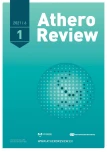How we are (un)successful in the managing of dyslipidemia and why
Authors:
Michal Vrablík
Authors‘ workplace:
Centrum preventivní kardiologie, III. interní klinika – klinika endokrinologie a metabolismu 1. LF UK a VFN v Praze
Published in:
AtheroRev 2021; 6(1): 46-49
Category:
Sources
-
Baigent C, Blackwell L, Emberson J et al. [Cholesterol Treatment Trialists’ (CTT) Collaboration]. Efficacy and safety of more intensive lowering of LDL cholesterol: a meta-analysis of data from 170,000 participants in 26 randomised trials. Lancet 2010; 376(9753): 1670–1681. Dostupné z DOI: <http://dx.doi.org/10.1016/S0140–6736(10)61350–5>.
-
Borén J, Chapman MJ, Krauss RM et al. Low-density lipoproteins cause atherosclerotic cardiovascular disease: pathophysiological, genetic, and therapeutic insights: a consensus statement from the European Atherosclerosis Society Consensus Panel. Eur Heart J 2020; 41(24): 2313–2330. Dostupné z DOI: <http://dx.doi.org/10.1093/eurheartj/ehz962>.
-
Kraml P, Vrablík M, Blaha V et al. Druhý konsensus EAS o lipoproteinech o nízké hustotě: stanovisko výboru České společnosti pro aterosklerózu. AtheroRev 2021; 6(1): 9–16.
-
Šatný M, Tůmová E, Vrablík M et al. Profil pacientů s nekontrolovanou arteriální hypertenzí a/nebo dyslipidemií v primární péči v Česku – studie LipitenCliDec: výsledky 1. fáze. AtheroRev 2020; 5(1): 47–52.
-
Šatný M, Tůmová E, Vrablík M. LIPIcontrol: daří se zlepšovat úroveň kontroly hlavních rizikových faktorů kardiovaskulárních onemocnění v každodenní praxi? Hypertenze KV Prevence 2018; 7(1): 15–21.
-
Ray KK, Molemans B, Schoonen WM et al. [DA VINCI study]. EU-Wide Cross-Sectional Observational Study of Lipid-Modifying Therapy Use in Secondary and Primary Care: the DA VINCI study. Eur J Prev Cardiol 2020; zwaa047. Dostupné z DOI: <http://dx.doi.org/https://doi.org/10.1093/eurjpc/zwaa047>.
-
Mach F, Baigent C, Catapano AL et al. [ESC Scientific Document Group]. 2019 ESC/EAS Guidelines for the management of dyslipidaemias: lipid modification to reduce cardiovascular risk. Eur Heart J 2019; pii: ehz455. Dostupné z DOI: <http://dx.doi.org/10.1093/eurheartj/ehz455>.
-
Sabatine MS, Giugliano RP, Keech AC et al. [FOURIER Steering Committee and Investigators]. Evolocumab and Clinical Outcomes in Patients with Cardiovascular Disease. N Engl J Med 2017; 376(18): 1713–1722. Dostupné z DOI: <http://doi: 10.1056/NEJMoa1615664>.
-
Schwartz GG, Steg PG, Szarek M et al. [ODYSSEY OUTCOMES Committees and Investigators]. Alirocumab and Cardiovascular Outcomes after Acute Coronary Syndrome. N Engl J Med 2018; 379(22): 2097–2107. Dostupné z DOI: <http://doi: doi: 10.1056/NEJMoa1801174>.
-
Vrablík M, Piťha J, Blaha V et al. Stanovisko výboru České společnosti pro aterosklerózu k doporučením ESC/EAS pro diagnostiku a léčbu dyslipidemií z roku 2019. AtheroRev 2019; 4(3): 126–137.
-
Cífková R, Bruthans J, Wohlfahrt P et al. 30-year trends in major cardiovascular risk factors in the Czech population, Czech MONICA and Czech post-MONICA, 1985 – 2016/17. PLoS One 2020; 15(5): e0232845. Dostupné z DOI: <http://dx.doi.org/10.1371/journal.pone.0232845>.
-
Deshpande S, Quek RG, Forbes CA et al. A systematic review to assess adherence and persistence with statins. Curr Med Res Opin 2017; 33(4): 769–778. Dostupné z DOI: <http://dx.doi.org/10.1080/03007995.2017.1281109>.
-
Mach F, Ray KK, Wiklund O et al. European Atherosclerosis Society Consensus Panel, Adverse effects of statin therapy: perception vs. the evidence – focus on glucose homeostasis, cognitive, renal and hepatic function, haemorrhagic stroke and cataract. Eur Heart J 2018; 39(27): 2526–2539. Dostupné z DOI: <http://dx.doi.org/https://doi.org/10.1093/eurheartj/ehy182>.
-
Nielsen SN, Nordestgaard BG. Negative statin-related news stories decrease statin persistence and increase myocardial infarction and cardiovascular mortality: a nationwide prospective cohort study. Eur Heart J 2016; 37(11): 908–916. Dostupné z DOI: <https://doi.org/10.1093/eurheartj/ehv641>.
-
Lebeau JP, Cadwallader JS, Aubin-Auger I et al. The concept and definition of therapeutic inertia in hypertension in primary care: a qualitative systematic review. BMC Fam Pract 2014; 15:130. Dostupné z DOI: <http://dx.doi.org/10.1186/1471–2296–15–130>.
-
Milman T, Joundi RA, Alotaibi NM et al. Clinical inertia in the pharmacological management of hypertension: A systematic review and meta-analysis. Medicine (Baltimore) 2018; 97(25): e11121. Dostupné z DOI: <http://dx.doi.org/10.1097/MD.0000000000011121>.
-
Ošťádal P, Táborský M, Linhart A et al. Stručný souhrn doporučení pro dlouhodobou péči o nemocné po infarktu myokardu. Cor Vasa 2019; 61(5): 471–480. Dostupné z DOI: <http://dx.doi.org/10.33678/cor.2019.064>.
-
Raal FJ, Stein EA, Dufour R et al. PCSK9 inhibition with evolocumab (AMG 145) in heterozygous familial hypercholesterolaemia (RUTHERFORD-2): a randomised, double-blind, placebo-controlled trial. Lancet 2015; 385(9965): 331–340. Dostupné z DOI: <http://dx.doi.org/10.1016/S0140–6736(14)61399–4>.
Labels
Angiology Diabetology Internal medicine Cardiology General practitioner for adultsArticle was published in
Athero Review

2021 Issue 1
Most read in this issue
- Inclisiran: the first siRNA approved by European Medicines Agency for treatment of dyslipidemias
- Second consensus statement of European Atherosclerosis Society on low-density lipoproteins: statement of Czech Society for Atherosclerosis
- Low concentration of plasma cholesterol and type 2. diabetes mellitus
- Early cardiovascular risk intervention means cummulation of positive impacts in time
